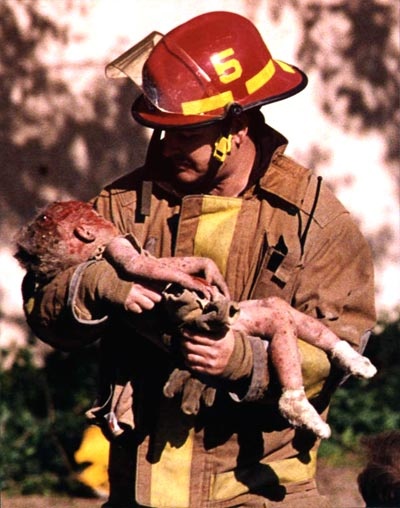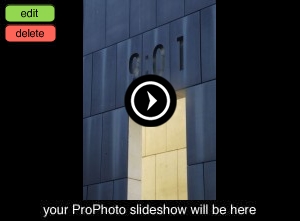Twenty years ago, an explosion ripped through the Alfred P. Murrah Federal Building, in Oklahoma City, at 9:02 in the morning. As a result of the actions of two cowards (not to be named in respect to the victims) 168 people, including 19 children, were killed and hundreds of others were injured. The attack stunned the entire nation – how could this happen in the heartland of America – at that time the worst terorrist attack on our soil.
Almost immediately a task force was formed to start planning a permanent memorial where this tragedy occurred. In October of 1997, President Clinton sign a law creating the Oklahoma City National Memorial as a unit of the National Park Service. The total cost of the memorial was 29.1 million of which 17 million coming from private donations. On April 19, 2000, the fifth anniversary of the attack, the Outdoor Symbolic Memorial was dedicated. On February 19, 2001 the Memorial Museum was dedicated. Approximately 350,000 people visit each year.
The Oklahoma City National Memorial is one of the most inspiring site you will ever visit. The Outdoor Symbolic Memorial sits on 3.3 acres and is open 24 hours a day 365 days a year. This site consist of the following segments:
- The Gates of Time: two twin bronze gates. These frame the moment of the blast – 9:02am. 9:01 is on the east gate and represents the last moment of peace, on the opposite gate is 9:03 which represents the moment of recovery. On each of the gates the following is inscribed: We come here to remember Those who were killed, those who survived and those changed forever. May all who leave here know the impact of violence. May this memorial offer comfort, strength, peace, hope and serenity.
- Reflecting Pool: This thin layer of water flows over polished black granite. The pool runs east to west down the center of the Memorial.
- Field of Empty Chairs: There are 168 empty chairs that were hand-crafted from glass, bronze, and stone. Each represents the victims of the blast with their names etched on the glass base of each. The chairs sit on the site where the Murrah building once stood. The chairs are arranged in nine rows which represent the nine floors of the building. Each person’s chair is on the row on which the person was located when the bomb went off. The chairs are groups also according to the blast pattern, most nearest the area of the building that was most heavily damaged. There are five chairs that are located on the most western section that represent the five people that did not die in the Murrah Building. Three of these people were in building near by, one outside of the building, and one was a rescuer. 19 of the chairs are smaller than the others, these representing the children that were victims. There of the women who died that day were expecting – these unborn children are listed on their mothers’ chairs beneath their mothers’ names.
- Survivors’ Wall: the only remaining original section of the Murrah Building are known as the Survivors’ Wall. It has several granite panels that were salvaged from the Murrah Building. The names of the 600 survivors are inscribed on these.
- The Survivor Tree: This tree is an American Elm and is located on the north side of the Memorial. It was the only shade tree in the parking lot across from the Murrah Building. People would arrive early to secure a parking spot under this tree. This tree can be seen in photos that were taken in the 1920s so the tree is about 100 years old. The Survivor Tree has glass and debris embedded in it’s trunk. Many of it’s branches were blown off by the blast. Although most believed the tree would not survive – it now THRIVES! It has been mandated that the tree will be protected as a living memorial. When the decking and wall were build around the tree a large portion of the roots were placed inside a large pipe so that it could reach the soil beyond the wall. There is an inscription on the deck wall that reads, The spirit of this city and this nation will not be defeated; our deeply rooted faith sustains us. Every year hundreds of seeds from the Survivor Tree are planted and the resulting saplings are distributed each year on the anniversary of the bombing. There are now Thousands of Survivor Trees growing on public and private land through the United States.
- The Memorial Fence: This 10 foot fence was build around the area of the reflection pool and chairs during the construction. I section of it was moved to the west side of the Memorial. Visitors still leave stuffed animals, poem, and other items.
- Children’s Area: There are more than 5,000 hand painted tiles from all over North America that were made by children and sent to Oklahoma City after the bombing. Most are stored in the archives there is a sampling on the wall in the Children’s Area.
- Rescuers’ Orchard: A grove of Oklahoma redbuds, Amur Maple, Chinese Pistache, and Bosque Elm trees have been planted on the lawn surrounding the Survivor Tree. These represent the rescuers who responded and gave aid to the survivors; this is why these surround the Survivor Tree.
- Journal Record Building: This building houses the Oklahoma City national Memorial Museum.
Many of us remember the scenes from April 19, 2095. We will never forget this tragedy as we watched this building destroyed along with the lives of so many, all of our lives changed that day. We should continue to pray for the victims and their families and salute the many responders who worked so hard to save the lives of the people in the building that day. I will never forget seeing a photo of Chris Fields, an Oklahoma City firefighter carrying 1 year old Baylee Almon away from the Alfred Murrah Building. Baylee later died in the hospital. She is truly an Angel and Chris is truly a HERO!
The actions of these two cowards is unforgivable and tragic. The loss of of the victims lives is heartbreaking. The actions of the first responders and the American people is inspiring. If you have not visited this memorial please do – not to take a selfie but to spend time honoring the victims and heroes of that day. You will be glad you did!
Tragedy is a tool for the living to gain wisdom, not a guide by which we live – Robert Kennedy
note: photo of firefighter Chris Fields and Baylee Almon taken by Pulitzer Prize winner Charles Porter

 Twenty years ago, an explosion ripped through the Alfred P. Murrah Federal Building, in Oklahoma City, at 9:02 in the morning. As a result of the actions of two cowards (not to be named in respect to the victims) 168 people, including 19 children, were killed and hundreds of others were injured. The attack stunned the entire nation – how could this happen in the heartland of America – at that time the worst terorrist attack on our soil.
Twenty years ago, an explosion ripped through the Alfred P. Murrah Federal Building, in Oklahoma City, at 9:02 in the morning. As a result of the actions of two cowards (not to be named in respect to the victims) 168 people, including 19 children, were killed and hundreds of others were injured. The attack stunned the entire nation – how could this happen in the heartland of America – at that time the worst terorrist attack on our soil.